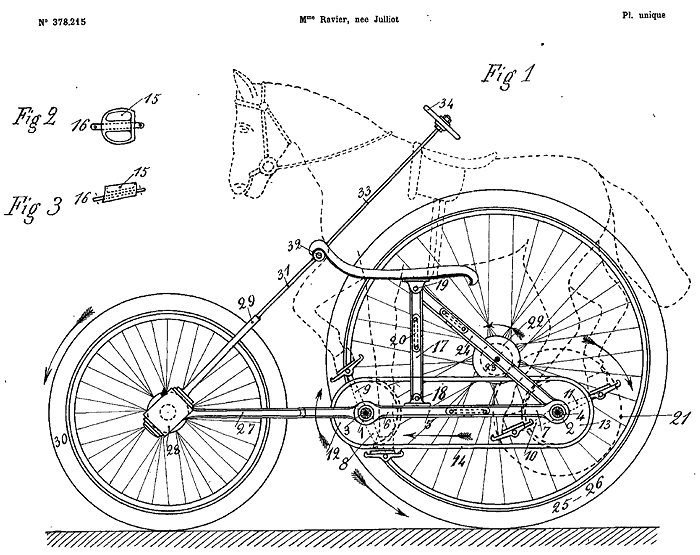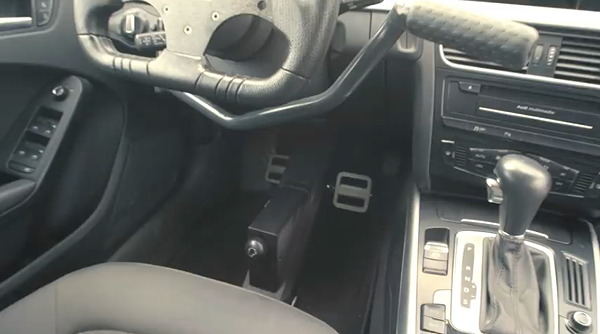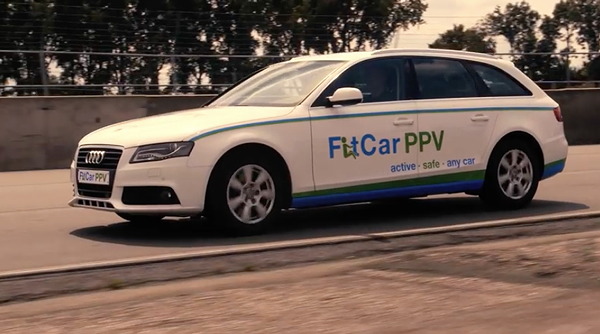Bicycles and Other Human-powered Vehicles
Madeleine Ravier’s Bicycle for Animals
Humans have invented mechanical devices, such as bicycles, that allow us to move faster by amplifying the power of our limbs. Madeleine Ravier of Paris argued that what works for people should also work for animals. So she invented and, in 1907, patented a "Cycles pour animaux," or 'bicycle for animals'.Her patent is in French, but the automatic translation is fairly comprehensible. Here's part of it.
Quite recently (less than 50 years ago), understanding the imperfection of his own limbs, he endowed them with mobile mechanisms, he put cycles, devices formed of 2 or 3 wheels between the legs. and of a few light and simple organs, with which he has prodigiously increased the extent of his movements without the help of external energy.
He thus achieved 370 kilometers in 12 hours (cyclist Cadolle), and even 45,764 kilometers (record of cyclist Bouhours), while excellent athletes, on their limbs, did not achieve, at most, at the same time of 12 hours than the already very high distances of 113 kilometers (walker 5o Hibbird) or ikh kilometers (rowell runner)....
What man did for himself he can do it for animals, or at least for some of them; There is a way to increase the efficiency of their limbs by the intercalation, between these limbs and the field of motion, of mechanical devices receiving the reciprocating motion of the limbs, transforming it into continuous rotary motion, and ending in rotating parts; and the result obtained can be used to make animals move man faster and farther than has hitherto been done by using them.
Ravier imagined making bicycles for all kinds of animals including "mules, donkeys, elephants, camels, dromedaries, etc.". But she started with a bicycle for horses, as shown below.

I have no idea if she ever built and tested one of these horse bicycles. The language barrier makes researching this a challenge.
Posted By: Alex - Sun Aug 08, 2021 -
Comments (5)
Category: Animals, Bicycles and Other Human-powered Vehicles, Inventions, Patents, 1900s
Five Weird Bikes
Narration not in English, but unnecessary for enjoyment.
Posted By: Paul - Sun Apr 26, 2020 -
Comments (0)
Category: Bicycles and Other Human-powered Vehicles, Inventions
Boycycle
Salvatore Ganacci - Boycycle from BUSINESS CLUB ROYALE on Vimeo.
Posted By: Paul - Sat Feb 22, 2020 -
Comments (2)
Category: Aliens, Beauty, Ugliness and Other Aesthetic Issues, Bicycles and Other Human-powered Vehicles, Body, Differently Abled, Handicapped, Challenged, and Otherwise Atypical, Cryptozoology, Family, Surrealism
Donkey Bike
Posted By: Paul - Fri Feb 14, 2020 -
Comments (1)
Category: Bicycles and Other Human-powered Vehicles, Inventions, 1960s
Follies of the Madmen #464

Source.
Posted By: Paul - Sat Feb 01, 2020 -
Comments (3)
Category: Bicycles and Other Human-powered Vehicles, Business, Advertising, Stereotypes and Cliches, 1950s, Men, Women, Alcohol
Five Green Men on a Bicycle
bicycle from Cool 3D World on Vimeo.
Posted By: Paul - Thu Oct 24, 2019 -
Comments (0)
Category: Bicycles and Other Human-powered Vehicles, Surrealism, Special Effects
Follies of the Madmen #437

1) A bicycle tire confusingly has the same name as a razor blade company.
2) The mascot for the tire is a hyper-dimensional polar bear. These creatures apparently represent all that is desirable in a tire.
3) Even with its magic powers, the hyper-dimensional polar bear does not act to save the victim directly, but makes the human boy do all the work.
4) Moral: buy our tires to avoid snake bites?
Source (page 20).
Posted By: Paul - Sun Jul 28, 2019 -
Comments (5)
Category: Accidents, Anthropomorphism, Bicycles and Other Human-powered Vehicles, Business, Advertising, Corporate Mascots, Icons and Spokesbeings, Comics
The car that’s like a bicycle
Nasser Al Shawaf was frustrated by the fact that he didn't get any exercise when he drove to work. So he teamed up with Dutch firm BPO and together they've created a car that has bicycle pedals instead of a gas pedal. So, you have to pedal to get your car to move. The faster you pedal, the faster it goes. The brake is controlled with a hand lever. The details:I suppose it would provide a disincentive to speeding if you had to pedal like crazy to keep going fast. So in that sense it's similar to the Deaccelerator that I posted about recently. Though it might make it hard to overtake people. After all, what if you got tired as you were trying to frantically pedal? And what if you were in mixed driving conditions where you had to switch rapidly from slow to fast speeds? How easy would it be to transition from slow to fast mode? Overall, I can only see this having very limited appeal.
More details.


Posted By: Alex - Sun Jan 20, 2019 -
Comments (4)
Category: Bicycles and Other Human-powered Vehicles, Inventions, Cars
Pram Side Car
The antecedent of all those modern tagalong baby trailers.
Posted By: Paul - Wed Oct 31, 2018 -
Comments (0)
Category: Bicycles and Other Human-powered Vehicles, Babies and Toddlers, 1950s
Brazilian bus driver training
In Cariacica, Brazil, part of the bus driver training is to have the drivers ride on a stationary bike while a bus zooms by them at top speed, to give them a sense of how cyclists feel.It seems like with each pass the bus got closer.
via bicycling.com
Posted By: Alex - Thu Oct 25, 2018 -
Comments (3)
Category: Bicycles and Other Human-powered Vehicles, Bus

| Who We Are |
|---|
| Alex Boese Alex is the creator and curator of the Museum of Hoaxes. He's also the author of various weird, non-fiction, science-themed books such as Elephants on Acid and Psychedelic Apes. Paul Di Filippo Paul has been paid to put weird ideas into fictional form for over thirty years, in his career as a noted science fiction writer. He has recently begun blogging on many curious topics with three fellow writers at The Inferior 4+1. Contact Us |




